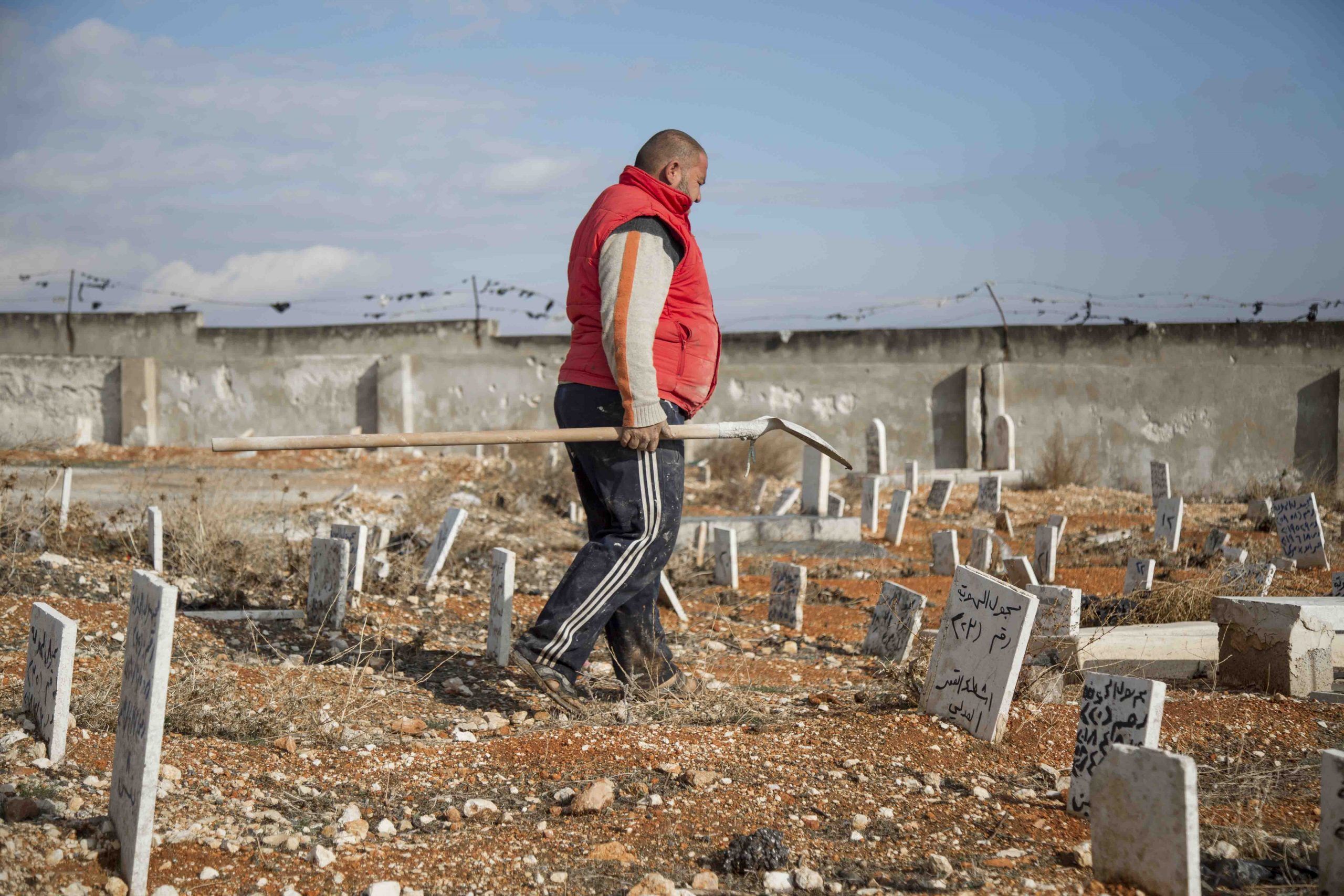“This Should Not Be Repeated”: Civilian Devastation, from Syria to Ukraine
In this photoessay, Elle Kurancid and Fadi Al-Shami compare the current crisis in Ukraine to the last decade of war in Syria.
By Elle Kurancid, Fadi Al-ShamiJuly 26, 2022

Cover photo: A graveyard for unidentified victims of the Syrian war, in the northwest city of Idlib, last December. Since Putin began bolstering Assad’s deadly campaign in autumn 2015, Syrian documentarian Fadi Al-Shami says he has seen more “nameless bodies” than ever before, with the first six months of intensified Russian airstrikes killing an estimated 2,000 civilians.
¤
TWELVE YEARS INTO the catastrophic war in Syria, and after five months of Russia’s all-out invasion of Ukraine, a tormenting truth grips Damascus-born, Idlib-based photographer Fadi Al-Shami. “One of the largest militaries in the world turned Syrian bodies into testing grounds for its lethal weapons,” he reflects — and now, Ukraine’s hospitals, schools, residential neighborhoods, and critical civilian infrastructure are also being targeted by Russian forces.
Like Syria’s Bashar al-Assad, the photographer continues, “Vladimir Putin aims to wreak havoc on as much civilian life as possible,” leaving thousands of Ukrainian civilians, young and old, dead and millions displaced, crucially, triggering Europe’s largest refugee crisis since World War II.
Around 1,200 miles from Ukraine — “the developing world’s breadbasket” — continuous conflict has forcibly displaced more than half of Syria’s population, creating what UNHCR calls, “the biggest humanitarian and refugee crisis of our time and a continuing cause for suffering.” Hundreds of thousands of Syrian civilians have been killed, including, on average, at least one child slain or injured every eight hours over the past decade. According to Human Rights Watch, the Russia-Syria military alliance, with its “indiscriminate aerial bombing of schools, hospitals, and markets — the civilian infrastructure essential to a society’s survival,” has committed war crimes, counting attacks that “may amount to crimes against humanity.”

Through a series of images, mostly captured over the past year and across the northwest province of Idlib — Syria’s last opposition-held enclave, where the war’s “worst displacement crisis” persists — Al-Shami shows us a conflict of the human spirit with the inhumanity of war.
A mother carries her child through their displacement camp after a severe rainstorm; a pickup truck carries the shrouded body of a young girl who was killed by an artillery shell.
A bombed house becomes a colorful antiwar mural; a family flees through a smoke-filled olive grove after the bombing of their neighborhood.
A displaced girl accepts a balloon from a volunteer clown; a weeping father grips a picture of his youngster who was killed by an airstrike.
Frame by frame, the photographer reminds us not only of the universal push and pull between life and death, but also how war accelerates and complicates this mortal struggle, often condemning noncombatants to early graves, mass graves, and inescapable economic and humanitarian free fall.
As Russia wages a withering assault on yet another civilian population, I ask Al-Shami, What is the vital lesson of the war in your country?
“War is not a school from which a person learns,” he replies, later adding that a potential teaching lies in “understanding the importance of life” — and thus refusing to render civilians “military targets.”








¤
Elle Kurancid is an independent writer based in the Mediterranean region.
Fadi Al-Shami is a freelance photojournalist based in Idlib province, northwest Syria.
LARB Contributors
Elle Kurancid is a Canadian literary journalist, story editor, and docufiction scriptwriter who lives in the Mediterranean region. Since 2014, she has collaborated with over a dozen documentarians on sociopolitical stories based in Egypt, Yemen, Greece, Kenya, Ireland, India, Syria, Lebanon, Palestine, Rwanda, Vietnam, France, England, and Canada. Her website is www.ellekurancid.com.
Fadi Al-Shami is a self-taught Syrian photojournalist. Since 2013, he has documented bombings, battles, demonstrations, displacement, and daily life across the northwest province of Idlib, where he is currently based, as well as on the frontlines of Jobar, his home neighborhood in Damascus. Follow his visual storytelling practice at www.instagram.com/fadi_al_shami_jo.
LARB Staff Recommendations
The Tragedy of Ukraine: On Olesya Khromeychuk’s “A Loss: The Story of a Dead Soldier Told by His Sister”
Khromeychuk shares the darkest and most intimate moments of a family experiencing tremendous loss.
Russia’s Blatant Violation of International Law
Don Franzen interviews Mark Ellis about the legal implications of the Russian invasion of Ukraine.
Did you know LARB is a reader-supported nonprofit?
LARB publishes daily without a paywall as part of our mission to make rigorous, incisive, and engaging writing on every aspect of literature, culture, and the arts freely accessible to the public. Help us continue this work with your tax-deductible donation today!